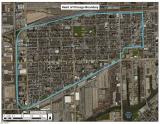Heart of Chicago Area Soils Site
EPA concluded the cleanup of lead-contaminated soil in 15 of the 21 residential in the Heart of Chicago Area Soils Site (PDF) (1pp, 31MB, About PDF) in September 2017. EPA did not receive access to address the other 6 residential properties. The Removal Summary Report (200 pp 32.59 MB, About PDF) was issued in December 2017.
EPA continues to work closely with the City of Chicago and neighborhood organizations to provide information to residents about steps they can take to reduce exposure to lead contamination in Pilsen Area soils.
Site Description and Activities
The site consists of about 580 acres, and is located in the Heart of Chicago neighborhood in Chicago. It is bounded by West 16th Street and railroad tracks to the north, South Loomis Street to the east, South Blue Island Avenue to the South, and Campbell Street and railroad tracks to the west. EPA personnel and contractors started setup activities in the Spring of 2017 and the last property cleanup was completed in September 2017. U.S. EPA generally contacted property owners prior to each individual property cleanup. Cleanup consisted of excavating contaminated dirt in the yards and gardens of homes with lead in surface soil greater than 400 parts lead per million parts soil. Parts per million is abbreviated “ppm.” Engineering controls such as dust suppression and monitoring were put into effect to protect workers and residents. The soil was disposed of at a permitted disposal facility. Yards were filled in with clean soil and restored to their original condition as much as possible.
As of September 30, 2017, yards at 15 properties were excavated, filled in with clean soil and restored. Six properties were not cleaned up because of access issues or no green space. EPA provided completion letters to the 15 excavated and restored properties in January, 2018 which documented EPA’s cleanup activities.
Site History and Background
In 2013, 21 soil samples from 20 residential properties were collected within the Heart of Chicago Area Soils site (originally called the Harrison Park site). The target zone was just west of the Pilsen Area Soils and East Pilsen Soils sites and was part of the routine background study area for the Pilsen Area Soils site when excessive lead levels were found. An additional residential property was identified, and two samples were collected from it in March 2016. All 21 residential properties had lead in surface soil greater than 400 ppm, with the highest concentration at 3,700 ppm.
Eleven potential industrial sources for the Heart of Chicago Area Soils site contamination were identified including former foundry and smelting operations. During 2015 and 2016, EPA collected samples from seven potential source locations. This study confirmed that the source of lead was industrial, but no clear connection between the potential source material and the residential samples was found. All of the former source locations have been heavily reworked, making a connection between any potential source and the residential properties very difficult.
In April 2016, U.S. EPA evaluated schools in the vicinity of the Heart of Chicago site (Orozco Academy & Cristo Rey Jesuit High School) and did not find any soil exposure areas. In November 2016, U.S. EPA conducted sampling in Harrison Park, and did not find elevated lead levels.
In summary, the site was found to have residential properties with elevated levels of lead in surface soils. Because of that and the potential for exposure of humans to lead, a hazardous substance, EPA carried out a removal action. Lead exposure by inhalation and ingestion can have detrimental effects on almost every organ and system in the human body. Off-site movement of the lead would greatly increase the potential exposure to nearby people, animals and the food chain.
Documents
- Removal Summary Report December 2017 (PDF) (200pp, 32.59K, About PDF)
- U.S. EPA Begins Lead Soil Cleanup Project (PDF)(2 pp, 390 K, About PDF)
- La EPA inicia proyecto de limpieza por tierra con plomo (PDF) (2 pp, 390 K, About PDF)
- Consent for Access To Property; Consentimiento para el acceso a la propiedad (PDF) (2 pp, 167 K, About PDF)
- Action Memo (Redacted) (PDF) (29pp, 2MB, About PDF) April 2017
- Pilsen Community is Focus of Continued Soil Sampling (PDF)(2pp, 171K, About PDF) June 2015
- La EPA continúa estudiando la tierra en áreas de Pilsen (PDF)(2pp, 172K, About PDF) June 2015
- Gardening in Lead-Contaminated Soil (PDF)(2pp, 225K, About PDF) 2013
- Jardinería en tierras con niveles de plomo (PDF)(2pp, 213K, About PDF) 2013
- Protect Your Family from Lead at Your Home (PDF)(2pp, 221K, About PDF) 2013
- Proteja a su familia del plomo en su hogar (PDF)(2pp, 221K, About PDF) 2013

